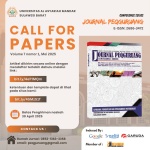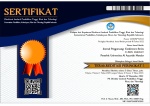Strategi yang Digunakan Guru Bahasa Inggris dalam Mengajarkan Pemahaman Mendengarkan di Pesantren IMMIM
Abstract
The study attempts to investigate the strategies used by teachers in teaching listening comprehension and to find out the students’ responses toward the strategies used. The study took place at IMMIM Islamic Boarding School, where four teachers and 88 of first and second grade students from 4 different classes participated. The study employed descriptive method, where the data obtained through observation, questionnaires, and teachers’ interviews. The study found that the teachers used some strategies in teaching listening comprehension, which had been categorized into Bottom-up, Top-down and Metacognitive. In bottom up, it was found that teacher 1 used audio program and dictation. Teacher 2 and 3 also used the same strategies with the teacher 1, while teacher 3 also used the same strategies as teacher 1 with the addition of pronunciation, grammar and mind mapping. In top down, teacher 1 used lecturing strategies, live listening, question-answer, discussion and checking. Meanwhile, teacher 4 used lecturing strategies, question-answer, visualization and discussion. In metacognitive category, all the teacher used planning and evaluate. Students’ responses toward the strategies used were positive. It is proved by the half of the students 56 (63.6%) gave the positive respond toward the strategy
Keywords
Full Text:
PDFReferences
Alwasillah, C. A. (2002). PokoknyaKualitatif: Dasar DasarMerancangdanMelakukanPenelitianKualitatif. Jakarta, Pustaka Jaya.
Anderson, A. & Lynch, T. (1988). Listening. New York: Oxford University Press.
Anderson, Stephen C. (1985). "Animate and inanimate pronominal systems Ngyemboon- Bamileke." Journal of WestAfrican Languages 15(2): 61-74.
Arikunto, S. (2006). ProsedurPenelitianSuatuPendekatanPraktis, EdisiRevisi. Jakarta: RinekaCipta
Barker, L., Edwards, R., Gaines, C., Gladney, K., & Holley, F. (1980). An investigation of proportional time spent in various communication activities by college students. Journal of Applied Communication Research, 8, 101-110.
Bird, D. (1953). Teaching listening comprehension. Journal of Communication, 3, 127- 130.
Brown, G. (1995). Dimensions of difficulty in listening comprehension. In D. Mendelsohn and J, Rubin (Eds.), A guide for theteaching of second language listening. (pp. 59-73). San Diego, CA: Dominie Press.
Brown, H. D. (1991). Breaking the language barrier: Creating your own pathway to success. Yarmouth, ME: Intercultural Press, Inc.
Brown, H. D. (2001). Teaching by principles: An interactive approach to language pedagogy, second edition. New York: Longman.
Chamot, A.U. (1987), 'The Learning Strategies of ESL Students'IN Wenden and Rubin, eds., 71-83.
Chiu, B. E. (2006). An Investigation of English Listening Strategies Used by Continuous Education Program Students in Taiwan. Retrieved February 25, 2016 from http://web.nanya.edu.tw/tcof/tcrd/word
Clark, H. H. & Clark, E. V. (1977). Psychology and language: An introduction to psycholinguistics. New York: Harcourt Brace Jovanovich Inc.
Coakley, C., &Wolvin, A. (1997). Listening in the educational environment. In M. Purdy & D. Borisoff (Eds.), Listening ineveryday life: A personal and professional approach (2nd ed.) (pp. 179-212). Lanham, MD: University Press of America.
Depdinas (2004) Kurikulum 2004: StandarKompetensi Mata PelajaranBahasaInggrisuntukSekolahMenengahPertamadan Madrasah Tsanawiyah. Jakarta: Depdiknas.
Devine, T. G. (1982). Teaching study skills. Boston, MA: Allyn& Bacon.
Dunkel, P. (1991b). Listening in the native and second/foreign language: Toward an integration of research and practice. TESOL Quarterly, 25, 431-457.
Ellis, R. (1985). Understanding Second Language Acquisition. Oxford: Oxford University Press.
Emilia, E (2010) Teaching Writing: Developing Critical Learners. Bandung: Risqi Press.
Erawati, J. A. (2013). Teacher Strategies In Teaching Listening Comprehensiolistening pass Bandung: UPI Repository.
Ferris, D. (1998). Students' views of academic aural/oral skills: A comparative needs analysis. TESOL Quarterly, 32, 289-318.
Ferris, D., &Tagg, T. (1996). Academic listening/speaking tasks for ESL students: Problems, suggestions, and implications. TESOL Quarterly, 30, 297-320.
Feyten, C. M. (1991). The Power of Listening Ability: An Overlooked Dimension in Language Acquisition. The ModernLanguage Journal 75:173-80.
Field, J (2008) Listening in the Language Classroom. United Kingdom: Cambridge University Press.
Flowerdew, J and Miller, L. (2005) Second Language Listening:Tlieorvand Practice. United States ot America: Cambridge University Press.
Gay, L. R. (2006). Education Research: Competencies for Analysis and Application Eight Edition. Colombus, Ohio: Pearson Education, Inc.
Gilbert, M. B. (1988). Listening in school: I know you can hear me--But are you listening? Journal of the InternationalListening Association, 2, 121-132.
Habte-Gabr, E. (2006). The Importance of Socio-affective Strategies in Using EFL for Teaching Mainstream Subjects. TheJournal of Humanizing Language Teaching, 8(5). Retrieved February, 2016, from
http://www.hltmag.co.uk/sep06/sart02.htm#C1
Harmer, J (2001) The Practice ofEnglish Language Teaching. Malaysia: Pearson Education limited.
Harmer, J (2007) Howto Teach English. China: Pearson Education Company
Henner-Stanchina, C. (1987). Autonomy as metacognitive awareness: suggestions for training self-monitoring on listening comprehension. M’elangesP’edagogiques17. Universite de Nancy 2: CRAPEL.
Jiang, Y (2009) Predicting Strategy and Listening Comprehension Vol. 5, No. 1 Asian Social
Science January, 2009. Qingdao University ot Science and Technology Qingdao 266061, Shandong, China. Available at http://www.ccsenet.orgjoumal/index.php.'ass.article/viewo40.
Lisha, M (2007) What Do Chinese EFL Listeners Need to Improve: Bottom-Up Skills or Top-Dowit Strategies? — A Cognitive Perspective on Chinese EFL Usteners^root Problems. CELEA Journal (Bimonthly) Jun 2007 Vol. 30 No. 3. Available at http://w'ww.celea.org.cn'teic/73.'73-03.pdf.
Lu, P. H. (2008). English listening comprehension strategy used by students of pre-sessional courses of Northumbria University, Unpublished master thesis, Southern Taiwan University.
 DOI: http://dx.doi.org/10.35329/jp.v5i2.4810
DOI: http://dx.doi.org/10.35329/jp.v5i2.4810
Article Metrics
 Abstract views : 132 times |
Abstract views : 132 times |  PDF - 121 times
PDF - 121 times
Refbacks
- There are currently no refbacks.
Alamat Penyunting & Distribusi:
JOURNAL PEQGURUANG: Conference Series
E-ISSN: 2686-3472
Gedung Biro AKSI. Lt 2. Ruang Lembaga Penelitian dan Pengabdian Masyarakat Universitas Al Asyariah Mandar
Telp./Fax (0428) 21038
Email: peqguruang@gmail.com
Website: https://journal.lppm-unasman.ac.id/index.php/peqguruan/index
Penerbit:
Lembaga Penelitian dan Pengabdian Masyarakat Universitas Al Asyariah Mandar
Indexed by:
Member of:

JOURNAL PEQGURUANG: Conference Series is licensed under a Creative Commons Attribution-ShareAlike 4.0 International License.










